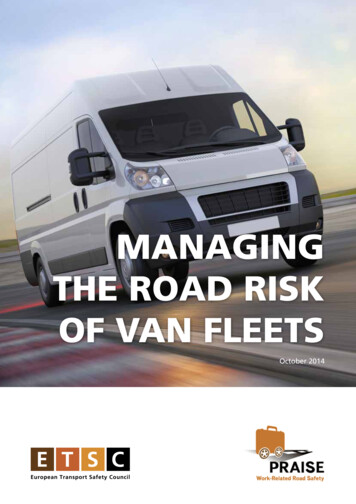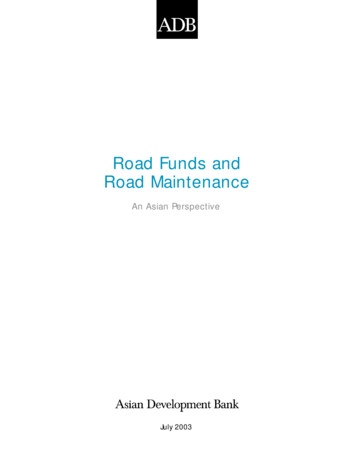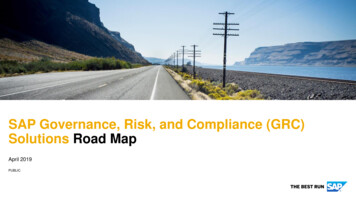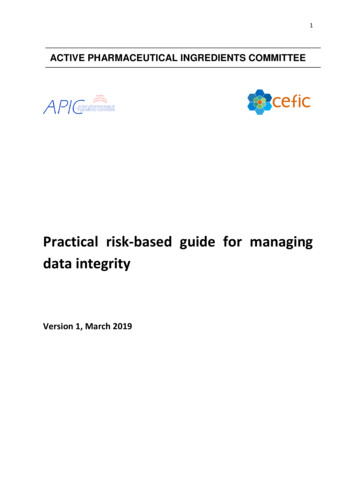
Transcription
MANAGINGTHE ROAD RISKOF VAN FLEETSOctober 2014
About PRAISEUsing the roads is a necessary part of our working lives. But it’san ordinary activity that leads to an incredibly high level of injuryand death. ETSC’s PRAISE (Preventing Road Accidents and Injuriesfor the Safety of Employees) project addresses the safety aspectsof driving at work and driving to work. Its aim is to promotebest practice in order to help employers secure high road safetystandards for their employees.The project is co-ordinated by the ETSC secretariat with thesupport of Fundación MAPFRE, the German Road Safety Council(DVR), the Belgian Road Safety Institute (IBSR-BIVV) and theDräger Foundation.Contributing ExpertsFor more informationETSC gratefully acknowledges the invaluable contributions ofthe following experts in the preparation of this report:European Transport Safety Council20 Avenue des CeltesB-1040 BrusselsTel: 32 2 230 e Lacroix – German Road Safety Council (DVR)Jesus Monclus Gonzalez – Mapfre FoundationRory Morgan – Iron MountainWill Murray – Interactive Driving SystemsFrancois Riguelle – Belgian Road Safety Institute (IBSR-BIVV)The contents of this publication are the soleresponsibility of ETSC and do not necessarilyrepresent the views of the sponsors or theorganisations to which the PRAISE experts belong.Deirdre Sinnott - Health and Safety Authority Ireland 2014 European Transport Safety CouncilAndrew Price – Zurich Insurance Group
MANAGING THE ROAD RISKOF VAN FLEETSAuthorsLuana BidascaEllen TownsendOctober 2014
CONTENTS1. Introduction 51.1 The business case for safer van transport52. What’s the problem? 63. The safety record of vans 74. Safer drivers 94.1 Driver hours 94.2 The EU Working Time Directive 104.3 Compulsory initial and periodic training for EU professional drivers104.4 Roadworthiness legislation 114.5 Type approval regulation 114.6 Speed limiters and Intelligent Speed Assistance (ISA)114.7 Risk assessment of the van and driver124.8 National-level legislation and policy 155. Safer vehicles 165.1 Vehicle management 165.2 Selection and procurement 165.3 Inspection and maintenance 175.4 Load securing 205.5 Reversing 235.6 Tailgating 246. Activity patterns: journey planning, fatigue and stress management256.1 Preventing stress 256.2 Fatigue: the scale of the problem266.3 Journey management and planning 266.4 Workplace Health Promotion (WHP) 276.5 Employer-level initiatives 287. Compliance with key traffic safety rules307.1 Seat belts 307.2 Speed 337.3 Alcohol and illegal and medicinal drugs367.4 Distraction 38BIBLIOGRAPHY 404 Managing the road risk of van fleets
PART IINTRODUCTIONThe purpose of this report is to give an overview of van safety issues in Europe, and toencourage and enable van fleet operators to navigate European legislation and applygood practice measures for their drivers and businesses. In line with frameworks suchas ISO 39001 or the Haddon Matrix, the report focuses on the business case, vehiclemanagement, journey management and compliance-led driver management.While ETSC believes it is in the public interest to tackle safety issues associated withthis vehicle category at the European and Member State legislative and non-legislativelevel, employers should also work to reduce the overall risk exposure of van driversand ensure that drivers and their vehicles are fit for the road.With this in mind, we offer recommendations to businesses throughout the report,together with policy recommendations for national and European-level legislators.1.1 The business case for safer van transportStudies into the road safety culture of employers of van drivers have shown that themotivation to manage risk goes beyond drivers – the company culture and the roleof management are highly important deciding factors for the degree to which roadsafety gets attention1. Research into this field has shown that safety measures aremore accepted, more effective and even more efficient when they connect to thecompany’s core business – both for internal business measures and governmental2.Contractors, maintenance companies, couriers and SMEs should gain more insightinto the positive consequences of safe behaviour as this might provide an importantbusiness incentive to invest in safety.From a business perspective, managing road safety in the van transport sector willprovide employers with an opportunity to reduce costs in several ways:Reduced running costs such as fuel consumption and vehicle maintenancethrough better driving standardsReduced risk of work-related ill heathLess stress and better job satisfactionReduced vehicle damageReduced administration around incident investigationReduced insurance claims and premiumsFewer vehicles off the road for repairLess employee absenteeismFewer missed orders and business opportunities.12Starren, A.M.L., Beek van der, F.A., Gort, J., 2013, Policy measures to stimulate the traffic safety of lorry vansby enhancing the company’s safety culture.Ibid.Managing the road risk of van fleets 5
An earlier ETSC report on making the business case for Work Related Road Safety(WRRS)3 quotes the costs and financial benefits that arrive from managing WRRS.ETSC’s report on Work Related Road Risk Management (WRRRM) Programmes4also gives an overview of the main WRRRM programmes available as well as bestpractice expertise from other companies that have implemented a risk managementprogramme. Both reports are highly relevant to employers managing van fleets.NOTE ON DEFINITIONThis report targets vans, also known as light commercial vehicles (LGVs). Accordingto the EU definition, vans are N1 category vehicles with a loading capacity of morethan 500 kilograms and a gross vehicle weight under 3.5 tons5. This definitionalso includes passenger vans – vehicles with a maximum capacity of 8 passengersexcluding the driver.PART IIWHAT’S THE PROBLEM?Van use in Europe is on the increase, particularly following a rise in the home deliverysector6. Developments in urban freight logistics have led to a shift towards vans, asthey bring goods to centralised distribution hubs and distribute them within urbanareas. More vans are also being used during office hours in central urban areas7,as heavier vehicles face increasingly restricted access to city centres. Night time vandeliveries are also increasing, extending supermarket deliveries to evenings or earlymornings. In addition, the online shopping phenomenon has led to a large increasein next-day deliveries of small items to households in particular.Vans weighingless than 3.5tons are notsubject to thesame legalscrutiny asheavy goodsvehicles (HGVs).In Belgium between 1997 and 2011, the number of vans increased by more than83% to 603 229 vehicles, or 1 van for every 8.8 cars. In the Netherlands the numberof vans has also been increasing rapidly over the last three decades, from slightlymore than 5% of all motorized vehicles in 1986 to nearly 10% in 20098. The pressureto keep up with market demands, competition in the transport of goods and arelative lack of regulation has led employers to bypass rules and this has affected theworking conditions of van drivers.Vans weighing less than 3.5 tons are not subject to the same legal scrutiny as heavygoods vehicles (HGVs).HGV regulations require operators to be licenced and thedrivers require Certificates of Professional Competence (CPC). Van fleets are, as aconsequence, perceived to lack the professionalism expected of HGV fleets. “WhiteVan Man” is often seen as an aggressive driver who speeds and does not respectother key road traffic rules. Yet there is also evidence to show that generally vans aresafer than passenger cars9,10. However, more can and should be done to improve thesafety of van fleets to bring them into line with the rest of the freight and passengertransport sector.ETSC, 2014, The Business Case for Managing Road Risk at Work.ETSC, 2012, Work-Related Road Safety Management Programmes.5European Commission, 2010, Light Goods Vehicles in the Road Transport Market of the European Union.6ETSC, 2010, Fit for Road Safety: From Risk Assessment to Training.7BESTUFS, 2006, Report on urban freight data collection in Belgium.8SWOV, 2010, Fact Sheet Lorries and delivery vans.9ETSC, 2013, 7th Annual Road Safety Performance Index (PIN) Report.10BASt, DEKRA, UDV, VDA, 2013, Safety of Light Commercial Vehicles.346 Managing the road risk of van fleets
PART IIITHE SAFETY RECORD OF VANS19% ofdeaths in vancollisions werepedestrians.A total of 3,999 deaths occurred in Europe in 2012 in collisions involving vans11,12.Alarge proportion of those killed were van occupants – 30% for vans compared with12% for HGVs – reflecting in part the lower weight of the van, which makes theiroccupants more vulnerable. It is also worth noting that more vulnerable road users arekilled in collisions involving vans, compared to the corresponding share in collisionsinvolving HGVs: 19% of deaths in van collisions were pedestrians, compared with14% of deaths in HGV collisions. With HGV traffic subject to entry restrictions inseveral urban centres in Europe13, smaller vehicles are being increasingly used for‘last mile’ deliveries, leading to an increase in the share of vans in urban traffic. Thisis leading to more van traffic and activity in areas of high pedestrian concentrationand offers a partial explanation for the observed figures. Road safety in urban areasshould therefore focus on the purpose, or function, of the vehicles entering urbanareas, rather than exclusively on their weight.The data from the countries that record the distance travelled by vans show that,per kilometre travelled, the safety of vans is generally better than that of the entirevehicle fleet14.Fig. 1: Road deaths incollisions with a vanper billion vehicle kmtravelled by thosevehicles (purple bars)with the correspondingrate for all vehicles(green bars). Averageof the last three yearsfor which the data isavailable.ETSC, 2013, 7th Annual Road Safety Performance Index (PIN) ReportGoods vehicles with a maximum permitted mass below 3.5 tons13For further information, please consult ETSC, 2009, 3rd Road Safety PIN Report, Chapter 4 En route to safermobility in EU capitals.14ETSC, 2013, 7th Annual Road Safety Performance Index (PIN) Report1112Managing the road risk of van fleets 7
In some countries, such as Belgium, there has been a worrying increase in thenumber of collisions involving vans; although the total number of collisions resultingin people killed and seriously injured (KSI) diminished by 27% between 1997 and2007, the ones involving at least one van have increased by 21%15.In Germany, collisions with vans between 2,8 and 3,5 tonnes have been analysedfor the period 1996 - 200816 and compared with vans between less than 2 and2,8 tonnes and with small HGVs between 3,5 and 7,5 t. The involvement of thisweight category (2,8 – 3.5) in accidents with personal injuries greatly differs from theother categories and increased by 300% between 1996 and 200117. After 2002 theincrease was less pronounced, but continued. In the same period, the involvementof all other categories of vehicles in accident with personal damages decreased by15%.In Spain, the crash involvement of vans in 2013 was 64% higher that the crashinvolvement of passenger cars: while 20.8% of delivery vans suffered a collision withother parties involved (excluding “solo” crashes), only 12.7% of passenger cars wereinvolved in the same type of crashes. According to this study, the crash involvementof business vans or passenger vans is still 27% higher than the crash involvement ofpassenger cars. This is of particular concern since passenger vans transport the mostvulnerable cargo18.A largeproportion ofdrivers also usedelivery vehiclesfor private trips.An in-depth study into 60 collisions involving 62 delivery vans by SWOV19,20, foundthat the lower stability of certain types of van seemed to contribute to the collisioninvolvement of these vehicles. The same study found that collisions involving deliveryvans had more serious consequences for the collision opponent than collisionswith passenger cars. This finding might be attributed to the design of delivery vans(higher, more angular shape and heavier). 72% of the collisions involved a light or amedium weight specific delivery vehicle.The characteristics of the vehicle type are a contributory factor especially in collisionsthat occur when the driver reverses (See Part 5.5 of the report) and when the vehicleperforms a near-side turn (left turn in the UK, Malta and Ireland, right turn in the restof Europe) and fails to give way to a cyclist or moped rider who travels straight. Inboth cases the van driver’s view is hindered by the design of their vehicle. Improperand unstable loading (part 5.4) can also have a big impact on the safety of vans as itmay cause skidding and loss of control.Some of the risk factors often quoted by the research21 available are that roadtransport companies often employ young drivers, vans collide more often withoncoming traffic and vans are frequently involved in rear-end collisions. Somestudies22 also note the large proportion of drivers who use the delivery vehicle forprivate trips. These types of vehicle may be company owned, but the vehicle’s journeyis not always work-related.Riguelle, F., & Roynard, M., 2014, Les camionnettes roulent-elles trop vite ? Mesure des vitesses pratiquées parles camionnettes sur les routes belges - 2013. Bruxelles, Belgique: Institut Belge pour la Sécurité Routière – Centrede connaissance.16Bast, 2010, Unfallbeteiligung von Kleintransportern.17This is explained in part by the significant increase of the van fleet in this period.18MAPFRE Foundation, 2014 (forthcoming), Dossier sobre seguridad de las furgonetas en España.19SWOV, 2010, Fact sheet lorry and delivery vans.20In this context, delivery van refers to mixed type of vans with a gross vehicle mass of up to 3.5 t.21SWOV, 2010, Fact sheet lorry and delivery vans.22Ibid.158 Managing the road risk of van fleets
PART IVSAFER DRIVERSThere are three different main types of legislative measure that affect van drivers:measures that improve competence (knowledge and skills) of driversmeasures that increase task capability (the degree of fitness to drive)measures that enhance task readiness (the willingness to drive safely)Van fleet risk isprimarily influencedby the employerwho has a key roleto play in settingthe agenda andrules about who,how, where andwhen vans can beused for work.Improving competence involves driver training, driving examination, professionaldriver diplomas, driving experience and extra training23. In 2005, the EuropeanCommission rejected a separate licence for van drivers. However as of 2007 drivers ofvans with heavy trailers attached (heavier than 750 kg) need a separate driving licence(category BE). ETSC’s recommendation is to extend the Certificate of ProfessionalCompetence to van drivers as well.Road collisions involving vans cannot be tackled by generic road safety measuresalone. The issue must be tackled by examining road safety, road traffic andoccupational health and safety measures collectively as they apply to van drivers andby mapping out a framework in which employees, employers and the self-employedwork towards compliance with all three aspects of work related road safety equally.In essence this means bringing road safety into the workplace and managing workersafety on the road. Van fleet risk is primarily influenced by the employer who has akey role to play in setting the agenda and rules about who, how, where and whenvans can be used for work.4.1 Driver hoursAs a rule of thumb,no driver should berequired to drivecontinuously formore than 2 hourswithout at least a15-minute break.Employers of HGV drivers have clear requirements under EU Regulation (EC)561/2006 regarding driving time for their employees. However, this legislation doesnot apply to van drivers (below 3.5 tons). Under this regulation, the driving and resttime periods must be recorded and compliance with these rules must be regularlymonitored using digital tachographs.The same principles enshrined in this legislation should be extended to cover vandrivers. Namely that: ‘A transport undertaking shall not give drivers it employs or whoare put at its disposal any payment, even in the form of a bonus or wage supplement,related to distances travelled and/or the amount of goods carried if that payment isof such a kind as to endanger road safety and/or encourages infringement of thisRegulation.’This should be extended to other parts of the supply chain including contractorsand sub-contractors24. This chain of responsibility should raise safety levels throughextending the scope of liability to those parties who, through action or inaction,contributed to a breach and therefore bear a level of responsibility for it25.Employers of van drivers are encouraged to set and enforce in-house limits forIbid.Subcontractors are very often self-employed and therefore they do not have to comply with social regulationrequirements. They have to travel more to earn money.25ETSC, 2011, Tackling Fatigue: EU Social Rules and Heavy Goods Vehicle Drivers.2324Managing the road risk of van fleets 9
Melanie Girouardunbroken driving hours, including daily, weekly and monthly limits for all classesof driver. As a rule of thumb, no driver should be required to drive continuously formore than 2 hours without at least a 15-minute break26. Breaks and break locationsshould be planned for in advance of starting journeys. (See part VI)4.2 The EU Working Time DirectiveDirective 2002/15/EC lays down minimum requirements with regard to theorganisation of the working time for all people performing mobile road transportactivities, including self-employed drivers, in order to improve road safety, healthand safety of drivers, and prevent distortion of competition. This Directive applies tovans heavier than 3.5 tons27.4.3 Compulsory initial and periodic training for EU professional driversThe legislation on the initial qualification and periodic training of drivers of certainroad vehicles for the carriage of goods or passengers (Directive 2003/59/EC) requiresEU professional drivers to follow a prescribed training syllabus. Driver training shouldbe part of an integrated approach to risk assessment by an employer with the aimof improving the safety of their operations. ETSC advocates the extension of drivertraining under the CPC to van drivers28.Very often the vans are driven by employeesfor whom driving is not the main activity in the company (postal workers, technicians,engineers, movers) but who have to drive on a daily basis, spending as much ashalf of their working time on the road. Usually these employees do not receive anyspecial training and can get behind the wheel of a van if they hold a valid B drivinglicence. Young driver and van familiarisation training should be a part of employeeinduction and training programs.A recent Spanish study has found that the crash involvement (excluding “solo”crashes) of van drivers with less than six years of driving experience is 80% higherthan the crash involvement of van drivers with more than 10 years of experience29.RoSPA, 2002, Safer Journey Planner.Ibid.ETSC, 2012, Fit for Road Safety: From Risk Assessment to Training.29MAPFRE Foundation, 2014 (forthcoming), Dossier sobre seguridad de las furgonetas en España.26272810 Managing the road risk of van fleets
4.4 Roadworthiness legislationAccording to EU legislation30 periodic testing should be the main tool to ensureroadworthiness of the vehicle. As a minimum requirement, vans should first bechecked four years after the date on which the vehicle was first registered, andther
Reduced insurance claims and premiums Fewer vehicles off the road for repair Less employee absenteeism Fewer missed orders and business opportunities. 1 Starren, A.M.L., Beek van der, F.A., Gort, J., 2013, Policy measures to stimulate the traffic safety of lorr











